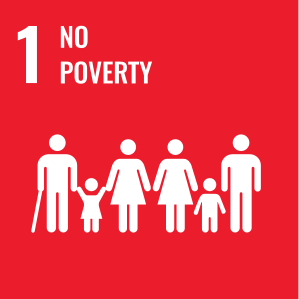
Back أهداف التنمية المستدامة - الهدف الأول Arabic Objetivo de Desarrollo Sostenible 1 Spanish Garapen Jasangarrirako 1. helburua: pobrezia desagerraraztea Basque هدف ۱ توسعه پایدار Persian Objectif de développement durable no 1 des Nations unies French יעד 1 לפיתוח בר קיימא HE Tujuan Pembangunan Berkelanjutan 1 ID Цел за одржлив развој 1 Macedonian ഒന്നാം സുസ്ഥിര വികസന ലക്ഷ്യം Malayalam Matlamat Pembangunan Mampan 1 Malay
| Sustainable Development Goal 1 | |
|---|---|
 | |
| Mission statement | "End poverty in all its forms everywhere" |
| Commercial? | No |
| Type of project | Non-Profit |
| Location | Global |
| Founder | United Nations |
| Established | 2015 |
| Website | sdgs |
Sustainable Development Goal 1 (SDG 1 or Global Goal 1), one of the 17 Sustainable Development Goals established by the United Nations in 2015, calls for the end of poverty in all forms. The official wording is: "No Poverty".[1] Member countries have pledged to "Leave No One Behind": underlying the goal is a "powerful commitment to leave no one behind and to reach those farthest behind first".[2]
SDG 1 aims to eradicate every form of extreme poverty including the lack of food, clean drinking water, and sanitation. Achieving this goal includes finding solutions to new threats caused by climate change and conflict. SDG 1 focuses not just on people living in poverty, but also on the services people rely on and social policy that either promotes or prevents poverty.[3]
The goal has seven targets and 13 indicators to measure progress. The five outcome targets are: eradication of extreme poverty; reduction of all poverty by half; implementation of social protection systems; ensuring equal rights to ownership, basic services, technology and economic resources; and the building of resilience to environmental, economic and social disasters. The two targets related to means of implementation[4] SDG 1 are mobilization of resources to end poverty; and the establishment of poverty eradication policy frameworks at all levels.[1][5]
Despite the ongoing progress, 10 percent of the world's population live in poverty and struggle to meet basic needs such as health, education, and access to water and sanitation.[6] Extreme poverty remains prevalent in low-income countries, particularly those affected by conflict and political upheaval.[7] In 2015, more than half of the world's 736 million people living in extreme poverty lived in Sub-Saharan Africa.[8] The rural poverty rate stands at 17.2 percent and 5.3 percent in urban areas (in 2016).[9]
One of the key indicators that measure poverty is the proportion of population living below the international and national poverty line. Measuring the proportion of the population covered by social protection systems and living in households with access to basic services is also an indication of the level of poverty.[5]
- ^ a b United Nations (2017) Resolution adopted by the General Assembly on 6 July 2017, Work of the Statistical Commission pertaining to the 2030 Agenda for Sustainable Development (A/RES/71/313)
- ^ United Nations Development Programme (2016), Leaving No One Behind: a Social Protection Primer for Practitioners, Foreword, accessed 30 September 2020
- ^ "Goal 1: No Poverty". United Nations Development Programme (UNDP). Retrieved 17 September 2020.
- ^ Bartram, Jamie; Brocklehurst, Clarissa; Bradley, David; Muller, Mike; Evans, Barbara (December 2018). "Policy review of the means of implementation targets and indicators for the sustainable development goal for water and sanitation". npj Clean Water. 1 (1): 3. doi:10.1038/s41545-018-0003-0. S2CID 169226066.
 Text was copied from this source, which is available under a Creative Commons Attribution 4.0 International License
Text was copied from this source, which is available under a Creative Commons Attribution 4.0 International License
- ^ a b Ritchie, Roser, Mispy, Ortiz-Ospina (2018) "Measuring progress towards the Sustainable Development Goals." (SDG 1) SDG-Tracker.org, website
 Text was copied from this source, which is available under a Creative Commons Attribution 4.0 International License
Text was copied from this source, which is available under a Creative Commons Attribution 4.0 International License
- ^ "Decline of Global Extreme Poverty Continues but Has Slowed". World Bank. Retrieved 2020-08-26.
- ^ "Poverty and conflict". GSDRC. 31 October 2016. Retrieved 2022-06-17.
- ^ "Goal 1 - End poverty in all it forms,everywhere". United Nations, Department of Economic and Social Affairs, Statistics Division. Retrieved 2020-08-26.
- ^ United Nations Department of Economic and Social Affairs (2016-07-20). The Sustainable Development Goals Report 2016. The Sustainable Development Goals Report. UN. doi:10.18356/3405d09f-en. ISBN 978-92-1-058259-9.
© MMXXIII Rich X Search. We shall prevail. All rights reserved. Rich X Search